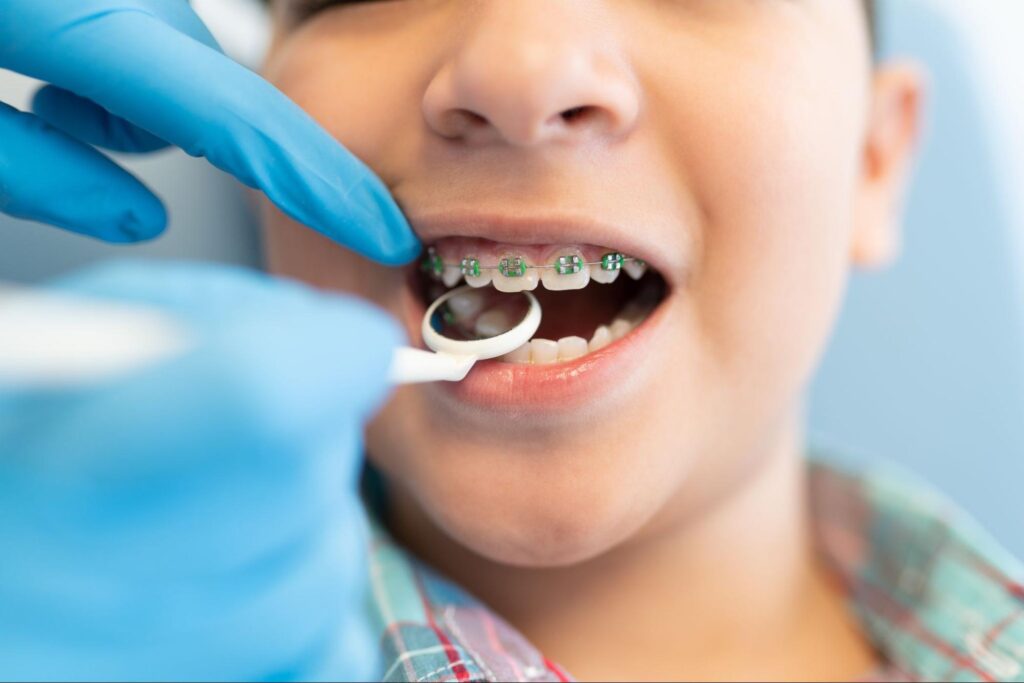When should your child see an orthodontist? It’s a question Dr. Bisig and Dr. Chermak hear all the time. The right time to get your child the orthodontic care they need is earlier than you might think. In fact, the American Association of Orthodontists recommends that all children see an orthodontist by age 7, and for good reason. Keep reading to learn why 7 is the magic number for a first checkup, what to expect at this visit, and what early intervention could look like.
7 Is the Magic Number
Getting braces is an exciting growth milestone, but because we are used to seeing teens with braces, it’s common for parents to be unaware that 7 is the best age for a first orthodontic appointment. There are several reasons why seeing an orthodontist at age 7 can make all the difference for your child’s future treatment and dental development– here’s why:
Mixed Dentition
By the time they turn 7, children usually have a good mix of both primary and permanent teeth, which gives Dr. Bisig or Dr. Chermak the ability to evaluate their dental development with a higher degree of accuracy as the permanent teeth start to emerge.
This is also an optimal age for evaluating your child’s jaw growth, which plays a pivotal role in their bite alignment. Typically, the only reasons you may hear your child would benefit from a phase 1 of treatment include a crossbite (both anterior or posterior), an impacted permanent tooth, a tongue/finger habit, or an underbite.
Habit Prevention
It’s very common for younger patients to exhibit harmful habits like thumb-sucking, mouth-breathing, or improper swallowing. Each of these practices can influence the way your child’s dental anatomy develops, but at age 7, they can still be easily corrected with proper intervention. By curbing these habits early, you can reduce the likelihood that they’ll need future orthodontic treatment.
Early Intervention
Certain orthodontic issues are much easier to correct while your child’s jaw bones are still growing. Early treatment at age 7 can guide their growth more effectively, leading to optimal outcomes that might not be as easily achieved once their face and jaws have stopped growing.

The First Visit
When your child sees an orthodontist by age 7, you’re helping set them up for long-term smile success. And because you want the best for them, knowing what to expect at your child’s first orthodontist appointment can put your mind at ease – and help you prepare your child for what will come as well!
Review Medical & Dental History
To get started, we’ll ask you some questions about your child’s past medical and dental experiences. This helps us form a baseline for addressing their orthodontic concerns, as well as offer answers to any questions you may have, like whether thumb sucking could cause future issues or if your child’s speech problems might be related to the position of their teeth.
Examine X-rays, Imaging, & Teeth
After we’ve covered the basics of your child’s dental health history, we’ll move on to the next stage: assessing their smile. We’ll take images of their teeth to better understand their dental anatomy – where the teeth are now and where their permanent teeth might come in. Your orthodontist will then conduct an oral examination to check for signs of emerging teeth, assess the relationship between their teeth and jaws, and look for any potential issues with bite alignment or jaw growth.
Discuss Treatment
Once your orthodontist has completed the exam, we’ll discuss expectations for future treatment. Many kids get braces in their later teen years, but it’s important to know that some children require an early round of treatment, known as Phase I. If this is the case for your child, Dr. Bisig and Dr. Chermak will discuss a potential treatment plan to give your child a head start on a straight smile.

All About Early Intervention
Not every little one needs orthodontic treatment at age 7, but for those who do, it’s important to become aware of their condition and get them started as soon as possible. For patients needing this extra attention, Dr. Bisig and Dr. Chermak implement a process known as Two-Phase Orthodontic treatment.
Phase I Treatment
If your child presents significant orthodontic concerns at their first orthodontic appointment, your orthodontist might recommend the use of a fixed or removable appliance to direct the growth of their jaw and dental arches, correct harmful oral habits, and help certain teeth emerge into better positions.
This stage isn’t typically about getting all of the permanent teeth into their final positions but about ensuring the jaw and dental structures are developing well enough to accommodate future growth and alignment as your child ages.
Retention
Once Phase I treatment is complete and your orthodontist has removed any fixed appliances, your child will start a resting period during which we won’t use any active orthodontic appliances (besides a retainer). The purpose of this phase is to allow their remaining permanent teeth to erupt without interference before moving on to Phase II of treatment if necessary.
Phase II Treatment
Now that your child has been through one round of initial treatment, we’ll put the finishing touches on their smile with a second round of active treatment. Usually, this phase involves using full upper and lower braces or clear aligners to straighten the smile in a process that looks more like the typical orthodontic treatment that most teens go through.

Set Your Child Up for Smile Success
Giving your little one a head start on a straight smile is the best way to improve their oral health and boost their confidence. Whether your child just needs a check-up or it’s time to start Two-Phase treatment, the team at Bisig + Chermak + Rudnicke Orthodontics is here for you and your family. Schedule your free consultation in Winston-Salem, Clemmons, or King to get started!



